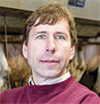Milking systems and lighting are two major areas of energy use on dairy farms, but there are money savings to be captured by performing proper maintenance and investing in energy-efficient equipment.
Milking system
Audits show that about half of the electricity in the dairy operation is associated with the milking process and cleaning the milking system. This provides several opportunities to reduce energy use.
Fix any leaking water faucets
Even slowly dripping hot water faucets will leak several gallons of water per year. It takes minimal costs to repair and keep all faucets working correctly. Consider installing an insulating blanket on the water heater and insulating the hot water pipes leaving the heater. Locate water heaters to avoid long hot water lines to reduce heat loss.
Proper location and maintenance of the compressor
In the summer, it is best to locate the compressor in a well-ventilated area for increased efficiency. Cleaning compressor fins quarterly can reduce milk-cooling costs by 3 to 5 percent. Technologies that will improve energy efficiency during the milk-cooling process include refrigeration heat recovery systems and plate coolers. A refrigeration heat recovery system uses compressor heat to preheat water, and the plate cooler uses well water to cool the milk.
Plate coolers can precool the milk and reduce cooling costs by 50 percent. A recent model showed that when all costs were included, it appeared that the refrigeration heat recovery system was the most cost-effective on farms up to a total milk volume of roughly 161,000 gallons per year. At higher milk volumes, the heat recovery system and plate coolers combined provide the greatest savings.
Variable speed drives
Variable speed drives for the vacuum pump and milk pumps are an excellent investment on many dairies. Variable speed vacuum pumps typically use 65 to 70 percent less energy that non-variable speed pumps. Table 1 shows the estimated payback of variable speed vacuum pumps. The payback will depend on cost, hours of operation and electricity cost.

An added advantage of a variable speed milk pump is that when combined with a plate cooler, the milk speed is slowed through the plate cooler, resulting in cooler milk entering the bulk tank. Newer scroll compressors on bulk tanks can reduce compressor energy costs as much as 20 percent, compared with older reciprocating compressors. When equipment needs to be replaced, consider equipment with higher energy efficiency ratings.
What about robots?
There has been a rapid increase in the installation of robotic milking systems throughout North America. Because the robots are operating 24 hours per day, there are questions about energy use comparisons to conventional milking systems. The Iowa Dairy Center in Calmar, Iowa, recently conducted an energy audit at their facility, which has both a parlor and robotic dairy.
Energy use was 1,592 versus 1,470 kWh per cow and 0.122 versus 0.116 kWh per liter of milk for the parlor versus the robot system, respectively. Other research has shown that robotic milking systems use more electricity than conventional milking systems. According to a paper written by Josh Jon Kaurich, there was a wide variation in energy use on three robotic milking farms, and he attributed it to differences in design and management. Consider energy use when designing any new dairy facility.
Lighting
Proper lighting is important for optimum cow performance and providing a safe and pleasant work environment. All farms should implement long-day lighting (18 hours of light above 15-foot candles) in the lactating cow housing area to maximize milk production. Managers, veterinarians and workers need sufficient light for observing cows, doing cow care tasks and assessing cow cleanliness before milking. Uniform lighting that minimizes shadows and dark entrances will keep cow traffic moving.
Because lights are on a substantial portion of the day, energy-efficient lighting is an easy way to reduce energy costs. It is important to replace burned-out bulbs and wash light fixtures on a periodic basis to maintain recommended light levels.
If incandescent bulbs are still used, they can simply be replaced with compact florescent bulbs, which use one-quarter of the energy and last much longer. The older T12 florescent tubes are 35 percent less energy-efficient per lumen than newer T8 lights and cost minimally more to install. Newer T5 lights are currently the most energy-efficient florescent bulbs available, but cost considerably more than T8s.
The newest technology is light-emitting diode (LED) lights. LED lights are very energy-efficient and can last 60,000 hours or more. They operate well in cold temperatures and are essentially instant-on devices. The main disadvantage is the initial cost. LED’s commonly cost two to three times more than comparable fluorescent lamps. The long, useful life reduces replacement lamp cost and labor costs to replace lamps. This, along with the higher energy efficacy, means LEDs potentially can be more economical over their life than other lights. Many factors should be considered when comparing lighting options and costs.
Many power companies offer rebate programs to upgrade to more energy-efficient lights.
Conclusion
Milk harvesting and cooling and lighting are two of the major energy uses on dairy farms. There are opportunities in each of these areas to improve energy efficiency while maximizing milk quality and animal well-being. Energy audits (either a self-audit or by a third party) can determine if changing management or investing in new technologies is cost-effective to implement. Proper maintenance will maximize performance and energy efficiency. Energy use changes can start small. Considering the energy use and production numbers simultaneously provides a different perspective to energy use. PD
References omitted but are available upon request. Click here to email an editor.
Jim Salfer is with the University of Minnesota Extension; Erin Cortus is employed at South Dakota State University; and Kevin Janni works with University of Minnesota.





